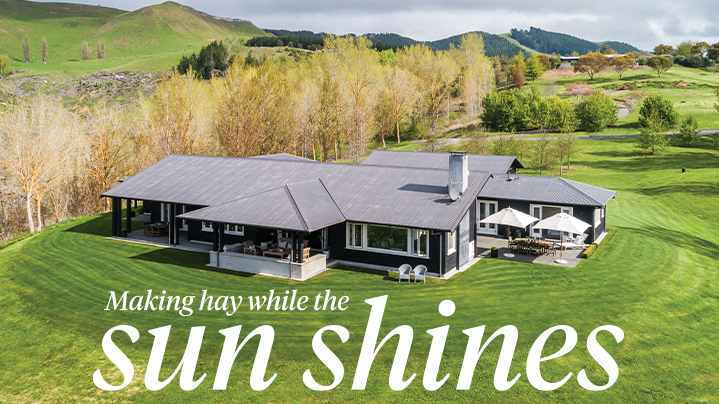Making hay while the sun shines
Seizing an opportunity to make the most of life beyond the city limits, the pandemic has seen a spike in rural sales activity, with Kiwis increasingly attracted to lifestyle properties for their mix of space, location and value.
Informed by the experience of a global health crisis, the rising cost of housing, and a quickly changing residential development landscape has seen more New Zealanders look to the outer reaches of urban areas and our regional centres for a mix of value and liveability.
“Across the country, the stop-go nature of lockdown restrictions has had a big impact on our lifestyle choices, with more Kiwis taking the time to stop and reassess lifestyle factors as they pertain to the family home,” says Raymond Mountfort, Bayleys Real Estate’s regional general manager of lifestyle.
However, demand has highlighted some interesting trends, with Bayleys’ dedicated lifestyle sales teams across the country noting a distinct spike in higher-end lifestyle properties of which there is a smaller pool of inventory.
Mountfort says rising enquiry for larger homes with a bit of land to play with and enough room for children, pets and leisure cruisers is seeing more Kiwis cast their net farther afield, with lifestyle properties noting a sustained uptick in enquiry since the onset of the pandemic some 24 months ago.
WHAT’S DRIVING INTEREST?
Our lives have changed dramatically over the last two years; a global pandemic has encouraged Kiwis to be more cognisant about where they live and who they interact with while supportive fiscal policy has pushed asset prices upward, and improved digital capabilities have enabled us to work from anywhere.
“Strong growth in the lifestyle sales sector has been underpinned by the perfect balance of economic, social and health considerations,” Mountfort says.
Rising property values in urban areas have brought about affordability constraints for many buyers who now see their money can net larger lifestyle-sized sections further away from the city.
While Kiwis have always had an innate connection to rolling hills and the great outdoors, Mountfort says pandemic-related change has been a clear disrupter of market dynamics.
“Lockdown restrictions and a virtual shutdown of workplaces across the world has forced businesses to invest in remote working structures, enabling employees to continue their duties away from the traditional office environment,” he says.
The work-from-home phenomenon has opened up Kiwi eyes to the possibilities of living in rural and semi-rural areas without the requirement of a daily commute into the city.
Similarly, urban sprawl and sustained investment into the transformation of greenfield sites to satellite cities continues to encourage new infrastructure in rural areas.
“Increased Government investment on the state highway and local road networks, along with other critical infrastructure such as schooling and healthcare allow new locations to flourish as thriving communities,” Mountfort says.
FRINGE BENEFITS
“Easing international border restrictions from January is seeing expatriate Kiwis and eager migrants that have been waiting in the wings seriously start their search for a home here, encouraged by the certainty of a new timeframe,” Mountfort says.
“Expatriates and those moving from overseas usually have a little more cash in their pockets, and after living in smaller properties in larger cities, are excited by the prospect of having room for their children to grow, keep a pet or start a hobby farm,” he adds.
The rising cost of living, especially housing, has also driven buyers to look for add-value potential in their next purchase.
“Anecdotal evidence shows that buyers today are looking for larger homes on bigger sites to future-proof their family requirements; this could be an extra wing for guests, a separate granny flat or the potential to build another dwelling for the kids as they grow up and start their own family,” he says.
ADVICE FOR MAKING THE MOVE
Looking to the 2022 year, Mountfort predicts we will continue to see an increasing trend toward movement out of cities and into regional and rural areas, as buyers look to balance affordability with lifestyle attributes.
“When first meeting these potential purchasers, we really want to find out what they are seeking from their move; do they simply want more land for their families, or is there a particular focus like keeping animals or growing a garden?”
• Bayleys’ lifestyle teams recommend buyers make a detailed list of what they want out of the move, to ensure they pick the right location for their needs.
• A depth of homework is advised, what do you know about the local community? If you want to care for animals, does the new property have the right fencing, shedding and facilities? If growing specific fruit or vegetables, do you understand local growing conditions?
• Engaging with the local community can help you to get a feel of what it would be like to assimilate into a new area.
• Your local Bayleys lifestyle team can offer valuable local knowledge, including history, local services and market information to help you to make the best and most informed decision.
• Bayleys’ team members always advise buyers to seek professional legal advice regarding the sale and purchase of any property including specific stipulations about easements, covenants and connections.
Read more...
[Download PDF]Subscribe to receive the latest residential news and insights from Bayleys’ View magazine.
